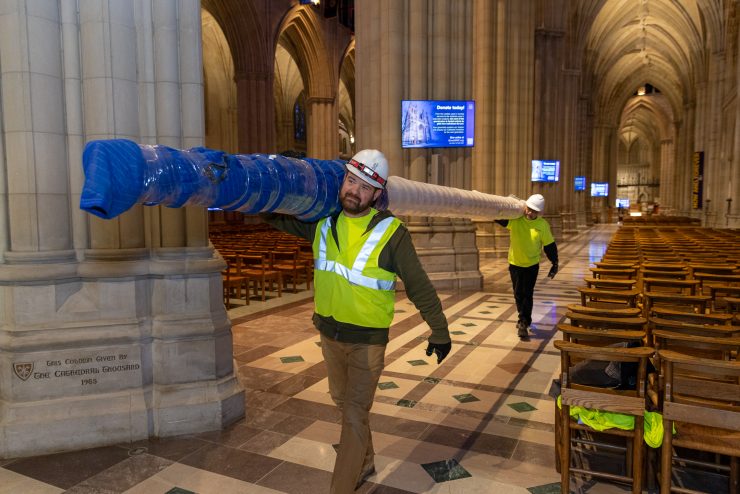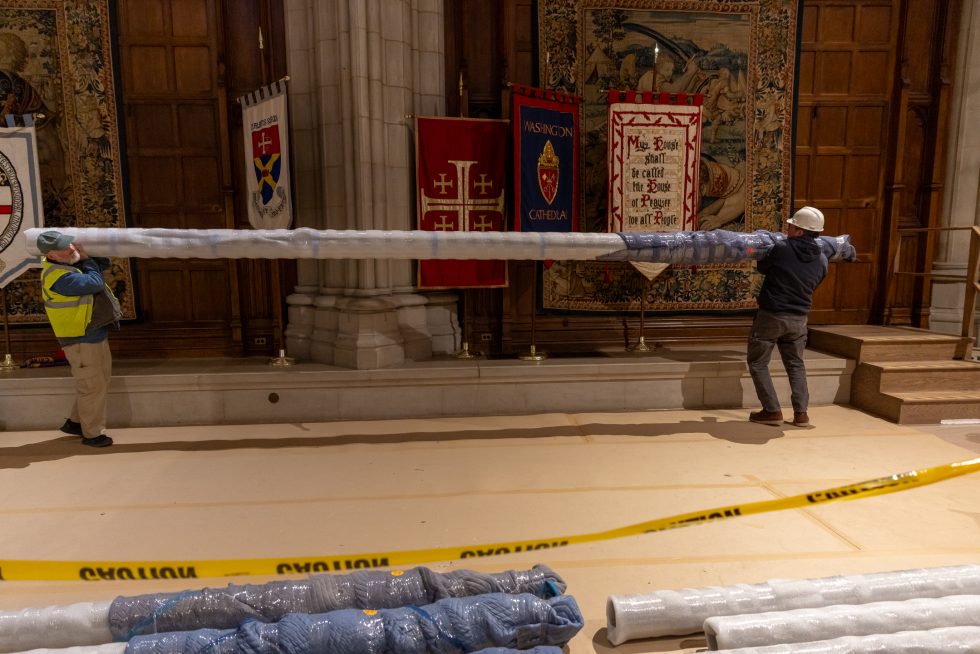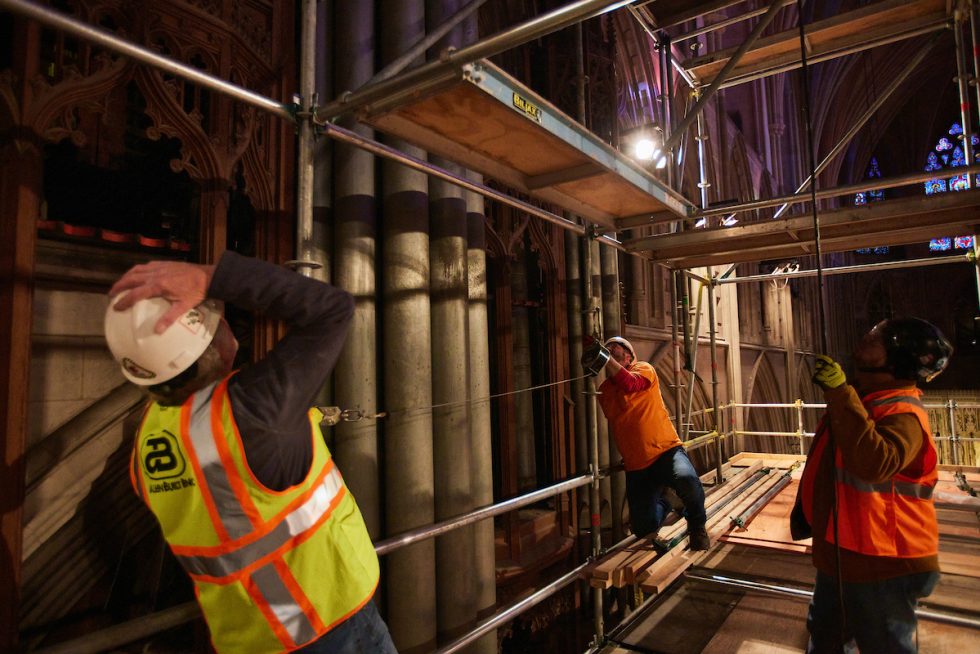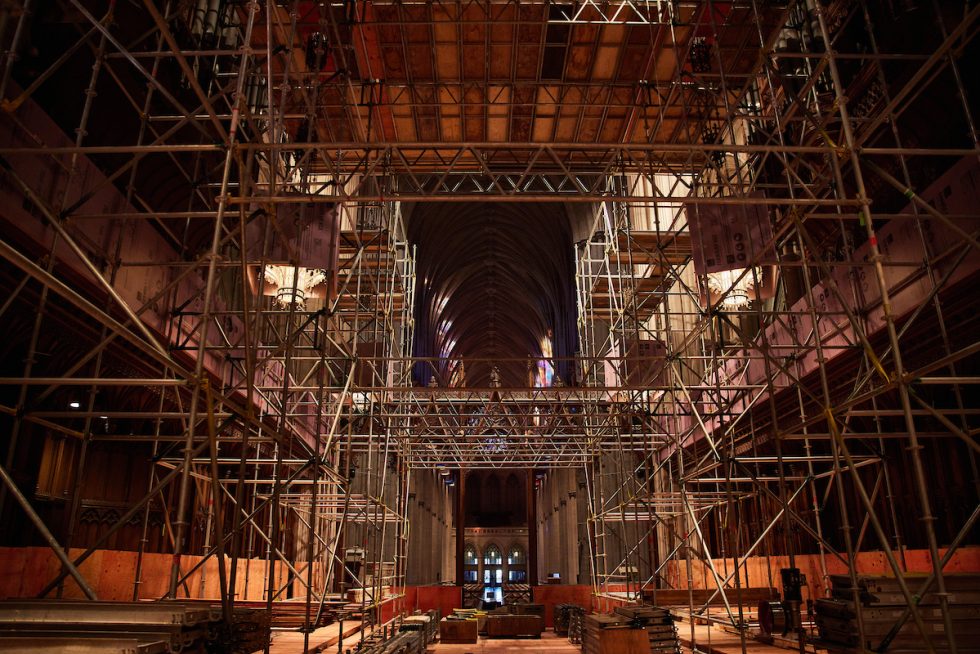Update: One Pipe Organ Leaves, Another (Digital) Organ Arrives
Anyone who has been in the Cathedral recently will have noticed massive scaffolding erected in the Great Choir. Here's what's going on.

This is the beginning of the removal of the main part of the organ. In order to create the elevated platform that will be suspended over the Great Choir (and allow for the removal and eventual reinstallation of the organ), we needed to build a forest of scaffolding that has completely taken over the Great Choir. Rest assured, that will all be gone before the end of March, with just the elevated platform (covered in a decorative scrim that will be visually harmonious with the architecture of the building) remaining, 40 feet above the floor.
The console of the old pipe organ, the blowers that provide the pressurized air for the pipes, and the façade pipes (the large visible pipes) have already been removed and taken to the Connecticut workshop of Foley-Baker, where those pieces will eventually be cleaned and restored so they can be reused in the organ.
LEARN MORE: Why (and How) We’re Renovating the Cathedral’s Pipe Organ
It was an intense week of work to get those components out of the Cathedral, but that pales in comparison to what they’ll be doing this summer when the rest of the organ’s thousands and thousands of pipes (some dozens of feet long and weighing hundreds of pounds) are removed.
In the meantime, since the odl pipe organ has played its last notes for some years, we are pleased to be the owners of a digital organ that has been custom built for us by the Walker Technical Company. This organ consists of a console exactly like a pipe organ console, a great deal of computer processing equipment to create the sound of the organ, several large amplifiers, and about 60 speakers of varying sizes all around the Cathedral. The specification of the Walker organ is the same as the renovated pipe organ will have, so it provides an opportunity for us to get used to the added versatility that this new specification has.
The capabilities of the digital organ are very similar to that of a pipe organ. It has four keyboards played with the hands and a pedal board played with the feet. It has hundreds of stops just like our pipe organ had and will have. While the sound of speakers will never be the same as the sound of pipes, it is in all ways an emulation of the experience of both playing and listening to a pipe organ, and because this organ is brand new, everything about it functions as intended, unlike the pipe organ we’ve just shut down!
One of the first things you will notice about the digital organ is that the console is located on the floor of the north transept, right by the wooden crossing platform. This is not its only location, though. The console sits on a wheeled platform, and the console is connected to the rest of the organ by a single cable, so it can be moved around the nave. What’s more, it has been designed so the console can be wheeled up ramps into the Great Choir; so once the Great Choir is usable again, we will have the option to move it to that space as well.
Already the experience of playing for a Sunday morning has been transformed by the fact that the organist is physically in the same room with the liturgy and the congregation. Before, the organist only had a couple TV screens and a monitor speaker as their only link to the nave. Now we still use one screen, but we also enjoy a situational awareness that we completely lacked before.
The installation of the digital organ was a fascinating process. The speakers had to be carried up the stairs, 40 feet up to the triforium level, in pieces, where they could be assembled in place. (The largest speakers are in cabinets about 4 feet long by 2 feet high and 2 feet wide.) Cables had to be run up from the current console location, up to the triforium, under the north rose window, and over to the amplifiers. A fiber optic cable was run around the apse of the Cathedral, over the high altar, so the two sides of the organ can communicate with one another.
And then, after all that, we had to make sure it sounded right in the Cathedral acoustic.
This process, called “voicing,” is when the organ gets its musical personality. Jeremy Rush, the voicer from Walker who did this here, had to work nights because of the busy Cathedral schedule. He would start in the evening when the building closed and work until sunrise, listening to every note of every stop and adjusting its volume and tone until the organ sounded exactly as he heard it in his mind. It was about five full nights of this work, but the painstaking work has really paid off. The sound of the instrument is glorious in the Cathedral, and we’re so glad to have it during this time that the pipe organ is gone.



